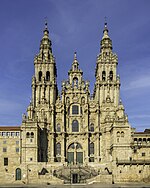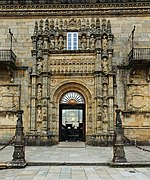Convent of San Domingos de Bonaval
Bien de Interés Cultural landmarks in the Province of A CoruñaDominican monasteries in SpainInfobox religious building with unknown affiliationMonasteries in Galicia (Spain)

The Convent of St Dominic (Galician: Convento de San Domingos de Bonaval; Castilian: Santo Domingo de Bonaval) is a former Dominican monastery in Santiago de Compostela, Galicia, Spain. The complex includes architecture in various styles including work by the Galician Baroque architect Domingo de Andrade. It was declared a national monument in 1912.
Excerpt from the Wikipedia article Convent of San Domingos de Bonaval (License: CC BY-SA 3.0, Authors, Images).Convent of San Domingos de Bonaval
Costa de San Domingos, Santiago de Compostela
Geographical coordinates (GPS) Address Nearby Places Show on map
Geographical coordinates (GPS)
| Latitude | Longitude |
|---|---|
| N 42.8825 ° | E -8.5388888888889 ° |
Address
Igrexa de San Domingos de Bonaval
Costa de San Domingos
15704 Santiago de Compostela
Galicia, Spain
Open on Google Maps









